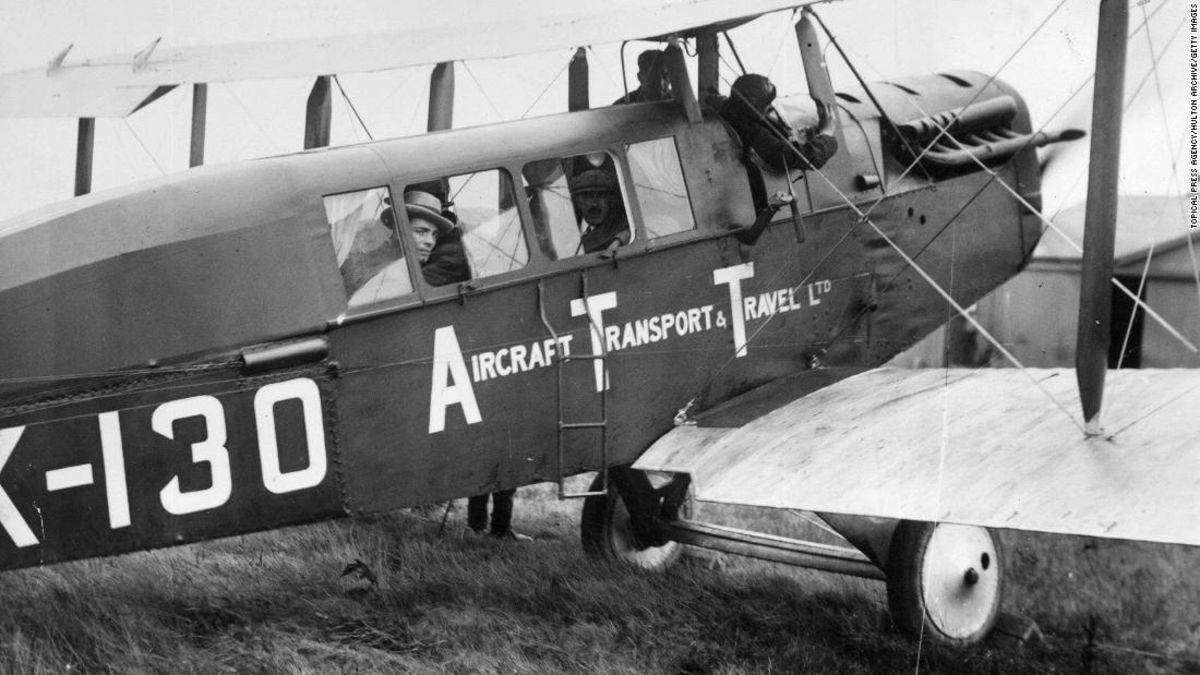(Topical Press Agency/Hulton Archive/Getty Images)
This fledgling flight, operated by Air Transport & Travel Ltd (AT&T) — a forerunner of British Airways (BA) — took off from Hounslow Heath, not far from what’s now Heathrow Airport, the British aviation hub where some 80 million passengers took to the skies in 2018.
Clearly international flights have changed a lot in the past 100 years, so let’s take a look back at where it all began.
Aviation milestones
Still, 100 years ago, aviation was often the sole realm of brave adventurers and experienced aviators, so the daily London to Paris passenger flight, although it also transported mail and parcels, represented a new era in commercial flying.
The glamorous ad also stressed the frequency of the new service — it departed daily, which seemed rather incredible at the time.

The first scheduled daily international service, about to depart from London to Paris.
Topical Press Agency/Hulton Archive/Getty Images
“The very early days it was very much just about persuading people to fly at all,” Jarvis says. “There were quite a lot of people who thought flying […] was just a passing fad.”
After all, the first non-stop flight from London to Paris took place only seven years earlier, and the first powered flight took place just 16 years earlier.
Aviation was still a new game.
Early days of flying

The flight took two hours and 30 minutes.
Topical Press Agency/Hulton Archive/Getty Images
The De Havilland DH4A G-EAJC aircraft, built for combat during the First World War and reimagined as a civilian airplane, made its way across the English Channel in a fairly swift two hours and 30 minutes. It was powered by a single Rolls Royce Eagle piston engine.
If you’re imagining a plane full of Brits ready to sample Paris’ baguettes and cheese, think again — it was a pretty small aircraft with limited, but intriguing, cargo.
Piloted by RAF veteran Lt E. H. “Bill” Lawford in an open-air cockpit, on board was one passenger, George Stevenson-Reece who was a journalist for London’s “Evening Standard” newspaper, plus a consignment of leather, two grouse and a few jars of Devonshire cream.
Stevenson-Reece paid 20 guineas for the journey (£21).
If that sounds like a good deal, bear in mind £21 in 1919 is equivalent to over £1000 ($1225) in today’s currency.
Weather conditions were apparently not particularly favorable, but the aircraft was greeted with enthusiasm by reporters and photographers upon landing in Le Bourget.
Later, flights on the service held up to 14 passengers.
Hot on the heels of the Brits, in 1920 Dutch airline KLM started flying aircraft between London and Amsterdam, and commercial aviation grew intermittently in the next few decades.
Still, it wasn’t until after the Second World War, Rolls Royce historian Peter Collins tells CNN Travel, that there was a “mindset change” that led to people embracing flying as a commonplace mode of transport.
“Although there were scheduled flights and aviation is developing and growing, it’s not massive […] It’s still for the well-off people,” he said.
